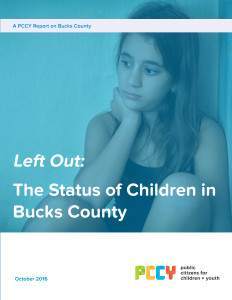Children Still in Recession in Delaware County Despite Recovery
El aumento de la pobreza infantil y el menor rendimiento de los estudiantes ensombrecen los modestos logros
 Philadelphia (Oct 17, 2016) – While recent headlines tout a national recovery from the Great Recession, more children in Bucks County are facing hardships than during the depths of the recession, a new study has found.
Philadelphia (Oct 17, 2016) – While recent headlines tout a national recovery from the Great Recession, more children in Bucks County are facing hardships than during the depths of the recession, a new study has found.
Ciudadanos públicos para la infancia y la juventud [PCCY] anunció nuevas informes completos on the status of children in Delaware, Montgomery, Bucks and Chester counties, entitled, “Left Out.” The Bucks County report, the second of the series, was released today.
“An American tragedy is happening right before our eyes, yet it’s very hard to see. The headline news touts a strong economic recovery, and monthly jobs reports amplify that message. But PCCY dug into the data and in Bucks County found a very different and alarming story that does not bode well for children or the county,” said Donna Cooper, Executive Director of Public Citizens for Children and Youth.
The new PCCY “Left Out” series unveils a Child Wellness Index that measures if children are worse off or better with respect four domains: K-12 education, early childhood education, health and economic well-being. Compared to 2008 when the recession was just beginning, in two Child Wellness Index domains – economic well-being and K-12 education – children in Bucks County are faring worse. For early childhood education their situation has not improved, while their health status has improved considerably.
“It’s pretty startling that in nine of the 16 Index measures, children were faring worse in Bucks County compared to 2008. Even where children are doing better, thousands of children are up against very bad odds,” said Cooper.
El repunte económico aún no llega a los niños
“We are seeing more formerly middle class breadwinners in Bucks County who have been battered by the recession and now need help to rebuild their skills so they can achieve lasting economic self sufficiency.” – Tam St. Claire, President of Bucks County Women’s Advocacy Coalition
- Five years after the recession (2015), Bucks County had a child poverty rate of 7.3%, or 9,583 children, still higher than the 6.2% at the start of the recession.
- Among the children in poverty, 6,300 are living in families earning less than half of the poverty level ($10,000 or less per year for a family of three), the highest level on record for the county and more than double the number in 2012.
La mayoría de los distritos escolares tienen menos fondos incluso con más estudiantes que necesitan ayuda adicional
“As a third term elected school director, I’ve had to make difficult decisions over the last decade. We have very good schools and great teachers. We can’t provide necessary resources because our state is at the bottom when it comes to the portion of costs for public education coming from the state. Underfunding requires local school boards to choose between cuts to academics, athletics and the arts, or; increasing taxes. I don’t like placing that burden on my neighbors, especially those on fixed incomes. But my first responsibility is to our students. I always hope our community will support serving our children.” – Mark Miller, Centennial School District Board Member
- By 2015, Bucks County school districts overall were spending almost $7,700 less per classroom than in 2008, the largest spending decline of any suburban county. Meanwhile, the disparity in instructional spending between the highest wealth (New-Hope Solebury) and lowest wealth (Bristol Borough) districts jumped to nearly $107,000 per classroom.
- As a result, student performance declined. More than 7,800 third through eighth grade public school students could not pass state reading assessments in 2014, a full 19.4% of students in the county. This fail rate is one point higher than in 2008. The fail rate for math also grew from 2008-2014, pushing it to 15.9%.
Access to Quality Early Learning Experiences Improved, But Most Poor Children Still Not Given this Smart Star
“Continuing to reach underserved children is a major goal. As the saying goes, ‘A hundred years from now… it will not matter what my bank account was, the sort of house I lived in, or the kind of car I drove…but the world may be different because I was important in the life of a child.’ Engaging parents, policy makers and the community in supporting this vision is essential to continuing progress.” – Pat Miiller, Coordinator for the Bucks County Quality Child Care Coalition
- Young families are struggling with the rising costs of child care in Bucks County, where three out of four children under six years old have all parents in the workforce. Full-time childcare for two children (a preschooler and an infant) totaled over $24,000, or nearly a third of the county’s median household income.
- More children in publicly subsidized child care were in high quality programs in 2014 compared to 2008, but still three out of four cannot get access to those programs due to shortages in public funds. Meanwhile fewer children were able to enroll in publicly funded pre-k, with 80% of eligible children in the county unable to enroll in high quality pre-k due to lack of public funding.
El estado de salud de los niños logró los mayores avances, pero los niños más pobres muestran signos reales de problemas
- The strongest public policy that protected children during the recession was the availability of state and federally subsidized health care coverage for children. In spite of job losses and cuts to employee benefit packages during the recession, the share of children insured rose a point from 2008 to 2014 to 98% thanks to CHIP and Medicaid. Still, approximately 3,150 children are uninsured, and many of them don’t have the option to enroll in publicly subsidized programs because of the state’s ban on undocumented children’s access to such health care supports.
- Racial health disparities are becoming more dramatic. In 2015, 27% of white children were obese, while the rate for black children was a whopping 2.5 times higher at 71%. Likewise, 6% of white children did not see a dentist in 2015 compared to 26% of black children.
La política pública ayudó a reducir la pobreza de las personas mayores, pero no lo hizo para los niños
- En todos los condados, la recesión económica afectó a miles de niños y adultos mayores, aumentando el número de personas en situación de pobreza en su punto más bajo. Pero a diferencia de las personas mayores, donde las políticas públicas efectivas les ayudaron a recuperarse más rápidamente en todos los condados suburbanos, los niños no recibieron las mismas protecciones. Estas políticas incluyen Medicare, Seguro Social, Cobertura de Medicamentos Recetados del Estado de Pensilvania (PACE), Reembolso de Rentas y Impuestos a la Propiedad de Pensilvania y políticas de impuestos estatales que excluyen las ganancias de jubilación de los impuestos estatales.
- From 2008 to 2015, the child poverty rate has been about 2% higher on average than the senior poverty rate in Bucks County. In 2013, the senior poverty rate began to decline, a full year earlier than the child poverty rate.
“Estos informes muestran que las buenas políticas públicas son muy eficaces para cambiar los resultados de la vida de los niños; en muchos casos, son las únicas herramientas que marcan la diferencia”. dijo Cooper. “Elected officials and their constituents have the opportunity to build the public will to adopt policies that protect children and strengthen the prospects of Bucks County.”
Recomendaciones de política
- Aumente la longevidad del trabajo y el pago: Aumentar el salario mínimo e implementar apoyos para la fuerza laboral, incluida la programación predecible y la licencia por enfermedad y familiar pagada.
- Aumentar los ingresos del hogar: Conecte a las familias con los ingresos federales y apoyos laborales como el Crédito Tributario por Ingreso del Trabajo, el Crédito Tributario por Hijos y SNAP.
- Alimente a los niños hambrientos: Ampliar la participación en el programa de comidas escolares.
- Ensure Health Care Access: Expand public health insurance to undocumented children.
- Elimine el envenenamiento infantil con plomo: Asegurar que los proveedores de salud financiados con fondos públicos realicen pruebas a todos los niños menores de tres años; remediar los hogares de mujeres embarazadas con alto riesgo de peligros relacionados con el plomo.
- Aumentar la asistencia escolar: Mejorar la forma en que los proveedores de salud pública abordan el asma, incluidas las visitas domiciliarias para reducir los desencadenantes del asma en el hogar.
- Reduzca aún más la tasa de embarazo adolescente: Aumentar el acceso a métodos anticonceptivos de acción prolongada para adolescentes con Medicaid.
- Expand the Reach of Early Intervention: Expand the use of early screening tools to identify all children in need of early intervention services.
- Haga que el cuidado infantil de calidad sea asequible: Utilice los recursos del estado y del condado para incentivar a los proveedores a mejorar la calidad y permitir que los proveedores que ya son de alta calidad se expandan.
- Expandir Pre-K: Incrementar la inversión estatal en prekínder para crear un asiento para cada niño elegible.
- Aumente el acceso al jardín de infantes de día completo: Eliminar las barreras financieras que limitan la capacidad de los distritos escolares para ofrecer kindergarten de día completo.
- Abordar la crisis de financiación escolar: Aumentar los fondos estatales para las escuelas públicas y distribuir esos fondos a través de la Fórmula de financiación de la educación básica.
Enlaces y gráficos
See the full Bucks County report at: https://www.childrenfirstpa.org/wp-content/uploads/2016/10/Left-Out_Bucks-County.pdf
See and share Bucks County indicator graphics at: https://www.childrenfirstpa.org/resource/left-bucks-county-indicators/
Vea los informes de los cinco condados en: https://www.childrenfirstpa.org/report/left-regional-reports-child-well/
